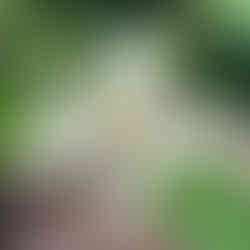Native Plants for a Tropical Vibe!
- Nuts for Natives
- May 24, 2023
- 4 min read
Updated: Jun 26, 2024
Color, flowers and foliage.

Garden centers in May are a kaleidoscope of color. Vibrant flowers, courtesy of annuals from across the globe, literally, catch our eye and brighten our spirits. It's so easy to be drawn in to the fun.

Views like this abound at your local garden center. As an avid fan of the British gardening show, Gardener's World, I have many a time been stunned to see the tropical paradises created by Londoners at the rear of row homes. Lush gardens brimming with tree ferns, cannas and annuals create oases you would never guess are in the center of London. While London is generally equivalent to USDA zone 8, a tad warmer than the center of the Chesapeake watershed, that doesn't explain it all. I think those gardeners just love a challenge.
That all got me to thinking, could one create a garden with a tropical vibe using native perennials, vines, shrubs and trees? I think we could! See what you think.
Groundcovers
Starting at the ground level, wild ginger (Asarum canadense) grows heart shaped leaves in shade. If wild ginger is planted in conditions it thrives in, within a couple of years, leaves can be 7" wide, quite tropical looking indeed.
Dwarf crested iris (Iris cristata) is another groundcover apt to spread once established. Dwarf crested iris grows in shade and part shade in medium to moist soils and blooms well in both. It is short, reaching just 6" in height. The spring flowers are beautiful and the light green, sword shaped foliage provides a lush fresh green color all summer long.
Flowers
Hibiscus is a quintessential tropical flower. It always amazes me that there are native hibiscus in the Chesapeake. Marshmallow hibiscus (Hibiscus moscheutos) and rose mallow (Hibiscus lasiocarpos) perennials have maroon, red and pink flowers oozing with a tropical feel. Slow to emerge in spring, hibiscus grow 4 to 6 feet high, or larger where they are happy, and grow best in sun and moist soils but can also grow in average soil.
Phlox paniculata 'Jeana' (Phlox paniculata 'Jeana') is a long blooming perennial that grows in sun and part shade. It gets tropical in its fuschia colored flowers.
The red and yellow flowers of Indian pink (Spigelia marilandica) lend themselves to our tropical paradise. Indian pink is a small, strong stemmed perennial the forms clumps 1 to 2' high and wide. The red and yellow tubular flowers emerge in a flush in early summer and then bloom sporadically the remainder of summer.
I am throwing spiderwort (Tradescantia virginiana) into the tropical mix as both the flower shape and bright purple color lend a tropical flair. Pink evening primrose (Oenothera speciosa) grows in full sun or part shade in most soil types. It's the closest native to the multitude of ornamental petunias in garden centers.
Vines
Now we really get going with a hint of the tropics. Any one of these vines would really add to this endeavor but put a couple together and you can't help but create your own paradise. Trumpet honeysuckle (Lonicera sempervirens) will be the first to flower with orange and coral colored flowers. Honeysuckle vines bloom with a huge flush of flowers in late spring. Vines, particularly those in sunnier locations, will continue to flower through summer, though not typically with the large numbers of flowers you get in spring.
Cross vine, generally a May bloomer, follows with orange hues for several weeks. Around the same time, American wisteria (Wisteria frutescens) adds deep purple, oh so tropical looking flowers. American wisteria provides just as many blooms as asian wisteria and greater habitat value. Even better, it’s not nearly as an aggressive grower as the asian wisterias.
Pipevine, or Dutchman's pipevine (Aristolochia tomentosa) will add oodles of foliage with large heart shaped leaves. It can grow up to thirty feet in one growing season. Pipevine grows in shade to sun and dry to moist soils and is perhaps most well known for being the host plant for the pipevine swallowtail butterfly.
Maypop, or purple passion flower vine (Passiflora incarnata), is easy to grow in full sun or part shade and adds pizzaz. The flowers look like dancing ballerinas more suited to the tropics than the mid-Atlantic. This vine is native to the eastern and southern U.S., starts blooming in July and keeps on going until September.
Ferns
Ostrich ferns (Matteuccia struthiopteris) are large moisture loving ferns that can create quite a stand of plants in the right location. Large ferns are very tropical! Sensitive ferns (Onoclea sensibilis) with thick deeply lobed foliage also look like warm weather plants. Really, I think you could include any of our many native ferns in your tropical garden.
Shrubs
For the shrub layer, oak leaf hydrangeas (Hydrangea quercifolia) have large leaves and flowers, reminiscent of a tropical forest. Smoke bush (Cotinus obovatus) also native to the southeast, has fresh green leaves and very unusual large feathery flowers. Carolina allspice (Calycanthus floridus) has a similar leaf shape and distinctive maroon flowers. All could be envisioned growing in a tropical jungle.
Trees
Bigleaf Magnolia (Magnolia macrophylla) is native to the southeast and a hard plant to find. The leaves, are so large they are evocative of a banana tree leaf. Much easier to find and native to the Chesapeake, is sweetbay magnolia (Magnolia Virginiana). Sweetbay blooms in late spring and early summer with a lemony fragrance. The leaves are also semi-evergreen.
Fringe tree (Chionanthus virginicus) is a small tree that grows to about 15' high and wide in full sun or part shade. The flowers give it its tropical credentials. Last, redbud trees (Cercis canadensis) are included for their heart shape foliage. The foliage morphs through the seasons as the color deepens. Seed pods in late summer and pale green and yellow leaves in fall add a tropical flair too.
What would you add to your tropical native garden? Or maybe you are not ready for that commitment. Perhaps a native hibiscus or two in a container on a deck or patio will suffice to transport you to the tropics!
Happy gardening.































































Comments